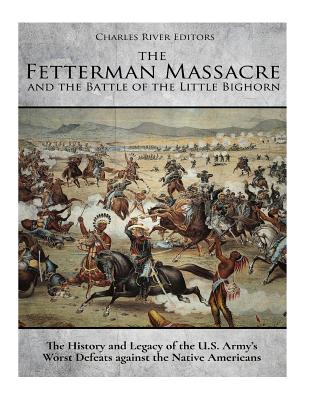The Fetterman Massacre and the Battle of the Little Bighorn: The History and Legacy of the U.S. Army's Worst Defeats against the Native Americans

The Fetterman Massacre and the Battle of the Little Bighorn: The History and Legacy of the U.S. Army's Worst Defeats against the Native Americans
*Includes pictures
*Includes accounts of the fighting
*Includes online resources and a bibliography for further reading
In the summer of 1866, Colonel Henry B. Carrington set out from Fort Laramie to establish a series of forts along the Bozeman Trail with the goal of protecting migrants moving along the trail. The Bozeman Trail ran through the Powder River country, which included the traditional hunting grounds of Lakota, Cheyenne, and Arapaho peoples. Carrington had about 1,000 people in his column, of which about 700 were soldiers and 300 were civilians, likely soldiers' families and migrants. The colonel established Fort Phil Kearny as his headquarters and based 400 troops and most of the civilians there. During the construction of Fort Kearny, which lasted months, Native Americans killed several dozen soldiers and civilians in some 50 separate attacks. The attacks were largely focused on the "wood trains", comprised of soldiers and civilians harvesting lumber from the surrounding forest for the construction of the fort. Though younger warriors like Crazy Horse conducted the actual attack, Red Cloud and other, older leaders would help plan and direct the harassment and interdiction campaign against the construction of Fort Kearny.
On December 21, Native Americans again attacked a wood train, and Carrington dispatched a mixed force of about 50 infantrymen and nearly 30 cavalry troopers and Colonel Carrington again chose Captain Powell to lead the relieving force, but Fetterman asserted his seniority to Powell and was thus given command of the soldiers. Again, Carrington ordered the troops not to pursue the warriors over the nearby ridge and out of sight of the fort. When Fetterman left the fort, he immediately disobeyed orders and took the trail that followed the ridgeline. Meanwhile, the Native American warriors had deployed a group of decoying riders, including Crazy Horse, who lured Fetterman's troops over the ridge and into the waiting ambush. At the time, the Fetterman Massacre, as U.S. newspapers labeled the event, was the greatest defeat (in terms of the number of U.S. soldiers killed) experienced by the Army at the hands of Native American warriors.
On the morning of June 25, 1876, George Custer's scouts discovered a Native American village about 15 miles away in the valley of the Little Bighorn River. Choosing to disregard his superiors' orders to wait for a concerted effort, the grandstanding Custer intended to del
PRP: 113.69 Lei
Acesta este Pretul Recomandat de Producator. Pretul de vanzare al produsului este afisat mai jos.
102.32Lei
102.32Lei
113.69 LeiLivrare in 2-4 saptamani
Descrierea produsului
*Includes pictures
*Includes accounts of the fighting
*Includes online resources and a bibliography for further reading
In the summer of 1866, Colonel Henry B. Carrington set out from Fort Laramie to establish a series of forts along the Bozeman Trail with the goal of protecting migrants moving along the trail. The Bozeman Trail ran through the Powder River country, which included the traditional hunting grounds of Lakota, Cheyenne, and Arapaho peoples. Carrington had about 1,000 people in his column, of which about 700 were soldiers and 300 were civilians, likely soldiers' families and migrants. The colonel established Fort Phil Kearny as his headquarters and based 400 troops and most of the civilians there. During the construction of Fort Kearny, which lasted months, Native Americans killed several dozen soldiers and civilians in some 50 separate attacks. The attacks were largely focused on the "wood trains", comprised of soldiers and civilians harvesting lumber from the surrounding forest for the construction of the fort. Though younger warriors like Crazy Horse conducted the actual attack, Red Cloud and other, older leaders would help plan and direct the harassment and interdiction campaign against the construction of Fort Kearny.
On December 21, Native Americans again attacked a wood train, and Carrington dispatched a mixed force of about 50 infantrymen and nearly 30 cavalry troopers and Colonel Carrington again chose Captain Powell to lead the relieving force, but Fetterman asserted his seniority to Powell and was thus given command of the soldiers. Again, Carrington ordered the troops not to pursue the warriors over the nearby ridge and out of sight of the fort. When Fetterman left the fort, he immediately disobeyed orders and took the trail that followed the ridgeline. Meanwhile, the Native American warriors had deployed a group of decoying riders, including Crazy Horse, who lured Fetterman's troops over the ridge and into the waiting ambush. At the time, the Fetterman Massacre, as U.S. newspapers labeled the event, was the greatest defeat (in terms of the number of U.S. soldiers killed) experienced by the Army at the hands of Native American warriors.
On the morning of June 25, 1876, George Custer's scouts discovered a Native American village about 15 miles away in the valley of the Little Bighorn River. Choosing to disregard his superiors' orders to wait for a concerted effort, the grandstanding Custer intended to del
Detaliile produsului









